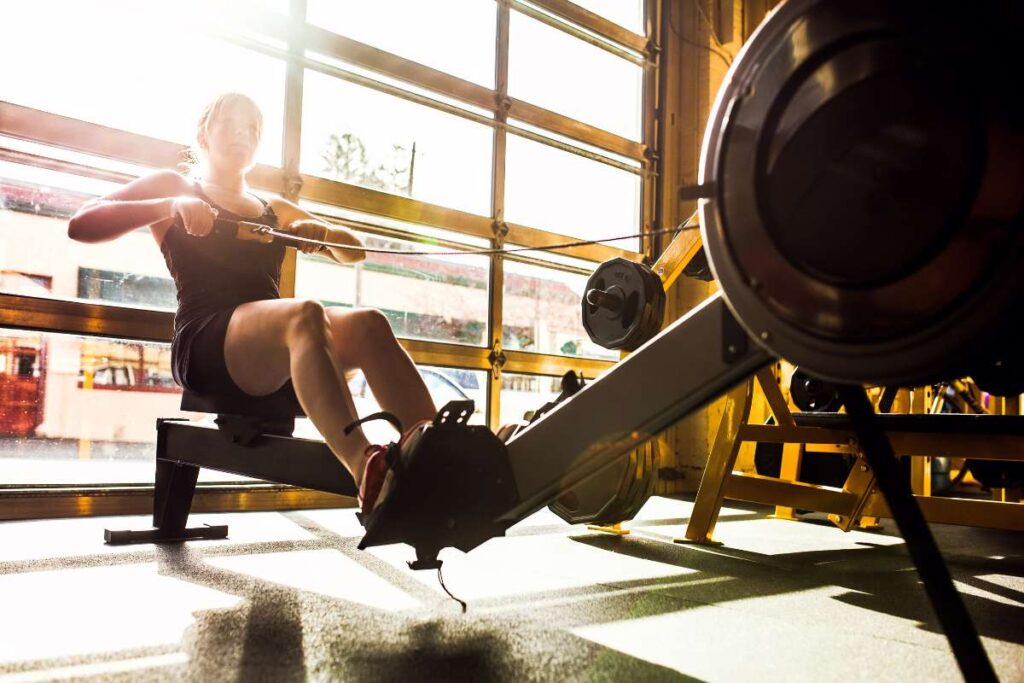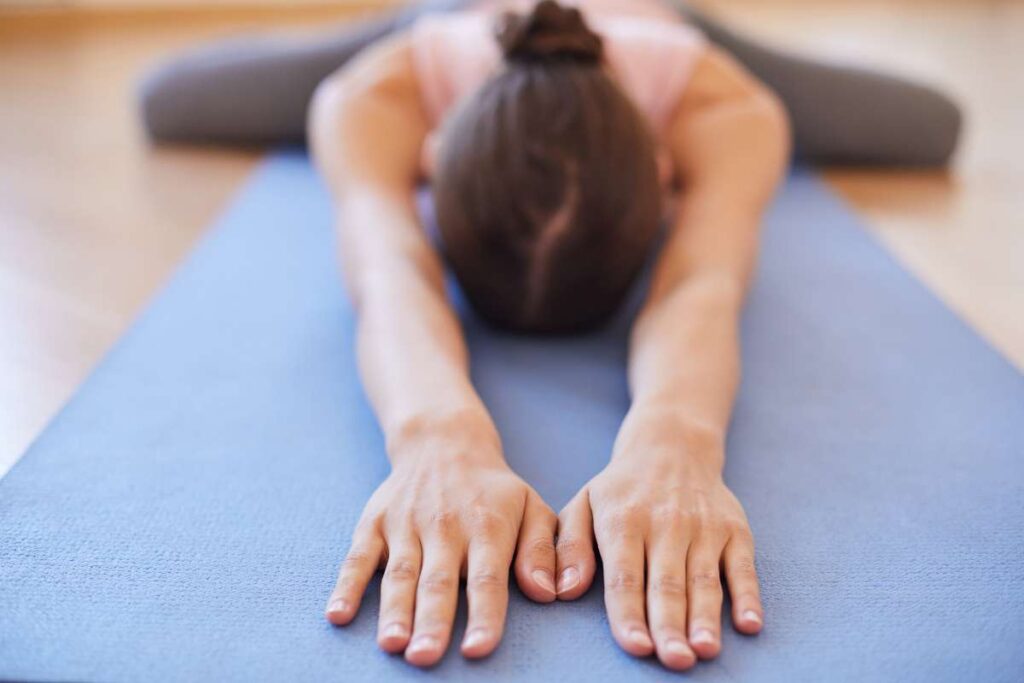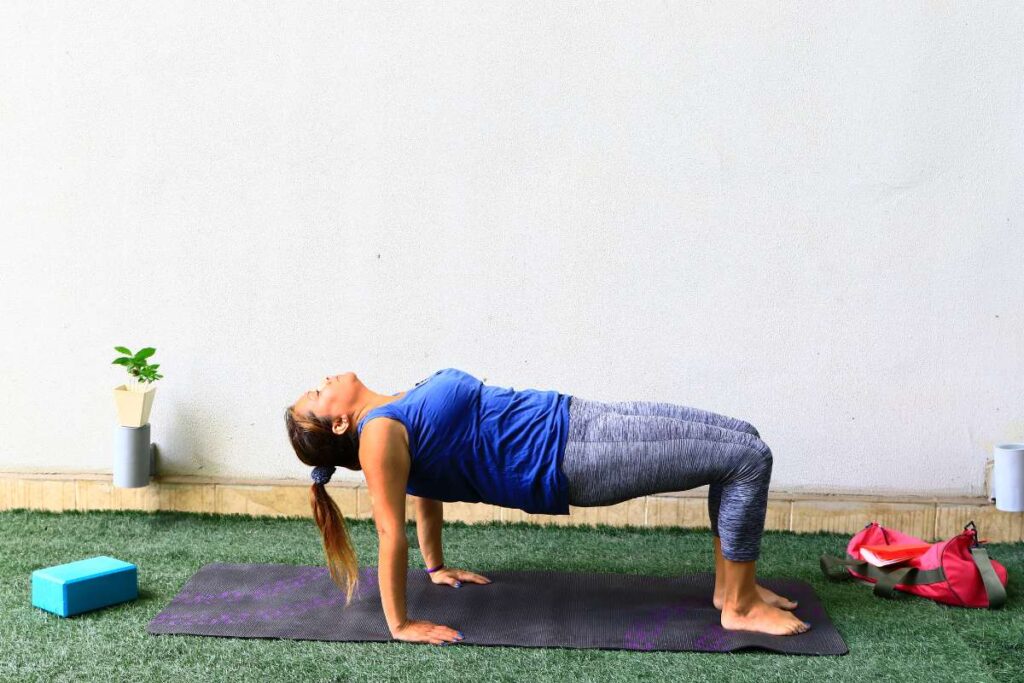This post may contain affiliate links at no additional cost to you. As an Amazon Associate I earn from qualifying purchases. Click to view our full disclosure.
What's inside
Welcome to my breakdown of the best chest stretches.
Are you someone who feels neck and upper back tension? Do you find it difficult to lift and press overhead?
Chances are, you have a tight chest, which is completely understandable given our lifestyles.
Be it long hours at the desk, stuck in traffic, or doom scrolling, it’s no wonder we feel locked up when it comes time to get moving and push weight.
But don’t worry, I have got you covered. This is sadly the norm, and one of the most common issues I have treated over my 13 years as a personal trainer and therapist.
Today, I’ll share the top 10 chest stretches to improve your flexibility. We’ll also cover the benefits of stretching the chest, types of stretching, common mistakes, plus professional tips to get the most out of your routine.
Let’s jump in.
Anatomy of the Chest Muscles
First, let’s talk about the anatomy of the chest. This will help you give you a better understanding of the muscles, their function, and which stretches will help you improve flexibility.
| Muscle | Function | Stretches | |
| Pectoralis Major | Flexion, adduction, and internal rotation of the arm. | Door Stretch Elbows 90°,Fitball Kneeling Chest Stretch 90°,Side Lying Chest Stretch | |
| Pectoralis Minor | Stabilizes and depresses the shoulder. Downward and internally rotated the shoulder. | Door Stretch Elbows 135°,Fitball Kneeling Chest Stretch 90°, Child’s Pose |
Main Benefits of Stretching Your Chest

There is no doubt that a good stretch feels great, especially when we have been cramped up at the desk all day. But what does it actually do for our bodies?
Here’s how the simple act of loosening up your chest can change your posture, improve your performance, and prevent injury.
Improves Posture
Lengthening the muscle of the chest is an excellent way to improve posture.
This is because the pec major and pec minor attach to both the upper arm and coracoid process of the scapula.
When we slouch, our pecs begin to shorten. This results in poor posture – formerly known as upper crossed syndrome – where the upper back is weak and the chest is tight.
However, when we lengthen these fibers, we reduce restriction at the front of the body and we allow our body to return to the upright position.
Increases Flexibility
Stretching our chest muscles is a great way to improve flexibility and range of motion.
Research indicates that performing a static stretch three times per week can lead to a greater range of motion.
It’s further stated that doing this over a number of years can result in long-term changes to their elastic structures.
Prevents Injury

When it comes to tendons, stretching has been linked to prevention of injury.
Studies indicate that performing dynamic stretches can be beneficial to increasing tendon elasticity and decreasing tendon injuries during jumping activities.
This not only prepares the body for the upcoming movements that are to be performed but also lays the foundation for stronger tendons and injury prevention.
Enhances Athletic Performance
Dynamic stretching has been linked and is often used to improve athletic performance.
Scientific studies indicate improvements to range of motion, followed by positive effects on generation of force, power, sprinting, and jumping.
This is likely due to increased muscle temperature and the introduction of movement prior to exercise and training.
Promotes Relaxation
Stretching has been known to promote relaxation and help many unwind.
A 2013 study found that performing a short stretching routine for 10 minutes after each workout day was effective in helping reduce anxiety, bodily pain, and feelings of exhaustion.
Participants also noted improvements to mental health, vitality, and flexibility.
Supports Respiratory Health
Stretching the chest muscles has been found to be beneficial in improving respiratory health.
One study focuses on patients with chronic obstructive pulmonary disease (COPD).
The participants were required to perform a range of stretches on breathing muscles, including the pec major and minor. The routine resulted in improvements to chest expansion.
While not all of us have this condition, the benefits of lengthening the fibers of the chest is evident and can be a great way to improve our breathing.
Improves Recovery
It’s true what they say, stretching does in fact help improve recovery.
A meta-analysis of 12 studies with a total of 2,000 participants finds that pre- and post-exercise stretching reduces muscle soreness.
While this is a small sample size, there is a good indication that throwing in a little stretch routine can help improve your recovery process.
Common Chest Stretches Mistakes

While simple, stretching your chest is not without its pitfalls. It takes more than just lifting your arms up and hoping for the best.
Careful consideration about positioning, timing, and breathing needs to be taken into account to avoid mistakes and the occurrence of injury.
Here is a list of common mistakes that are found when chest stretching.
Stretching Into Pain
Stretching to the point of pain is a major mistake that seemingly everyone has picked up along the way.
Whether it is from sports coaches or simple misinformation, stretching for a pain can give us the wrong idea about what we are attempting to achieve.
While studies do reflect that high-intensity stretching is beneficial for producing greater and longer-lasting flexibility, we recommended doing so in increments.
By performing your chest stretch at low and high intensities you will adopt a healthier relationship with your routine.
This will allow you to focus on lengthening the tissue rather than simply chasing a pain response and hoping for the best.
Holding Your Breath
One of the main offenders when it comes to chest stretching is holding our breath.
When we do this, it can be difficult to relax into the stretch and allow the muscle to fully lengthen.
A recent study (2022) looked at the effects of breathing on mobility. It found that a controlled breathing program prescribed by physiotherapists improved joint mobility.
While the exact programming won’t necessarily apply to your program, relaxing and breathing during your chest stretch will help your tissue to relax and mobilize the joints.
Not Strengthening Your Back

One of the main mistakes we see people who want to improve chest flexibility is that they do not strengthen the muscle of the upper back.
As previously mentioned, chest tightness can be due to poor posture and a lack of strength through the upper back.
When we stretch the chest but don’t strengthen the back, we are only doing half the job.
By performing the chest stretches with a series of back strengthening exercises such as rows, we lengthen the muscles at the front of the body and pull them back with our shoulder blades.
The result, a longer lasting, upright posture that can be sustained during the day.
Slouching
Slouching when performing your chest stretch is a mistake that will reduce the effectiveness of the stretch.
When we slouch and round our shoulders inward, we are resisting our stretching and smothering the lengthening process.
To avoid this and get the most out of your stretch, pin your shoulder blades back and externally rotate the shoulders.
This will get your shoulder joint and spine into a better position and put you in a great place for an awesome stretch.
Incorrect Arm Position
Incorrect arm positioning is a mistake that is commonly seen with chest stretching and can be the difference between hitting the chest or missing it altogether.
This is due to the attachment point of the pec muscles into the upper arm and scapula and their designed range of motion.
To get a great pec stretch, aim to have your upper arm positioned 90° abducted. Have your elbow flexed 90° to form a right angle, with your shoulder slightly externally rotated.
From this, position your shoulder at 90° to target the pec major, or lift it up to 135° to target pec minor.
Types of Chest Stretches
Let’s discuss the types of stretches, and their application. This will ensure that you are performing the correct stretch at the right time to maximize results.
Static Chest Stretches

Static chest stretching refers to the holding of a stretch in a single position for a desired amount of time.
Performing stretches such as the door stretch, fitball stretch, and child’s pose for a select duration allows your muscles to lengthen as you relax into the stretch.
This type of stretching is best performed post-workout as a cool down, where your muscles are warm and can fully relax into the stretch.
Dynamic Chest Stretches
Dynamic chest stretches are performed as a continuous movement through a full or near-full range of motion.
Movements such as chest openers, shoulder swings, or pressing movements prior to a chest session replicate the movement we are about to perform.
This is the preferred means of stretching before exercise, as passive stretching can impair performance.
Studies indicate that dynamic stretching can increase range of motion while maintaining maximal force output, explosive force, and power.
Top 10 Chest Stretches to Include in Your Workout Routine
Related: 10 Best Chest Exercises For Women

Here are the top 10 chest stretches to include in your workout routine.
I’ve split these into passive and dynamic stretches, followed by how to perform them and their benefits so you can apply them to improve your flexibility and avoid injury.
Passive Chest Stretches

1. Fitball Chest Stretch
The fitball chest stretch is a great movement for opening the chest in from a gentle and controlled position on the floor.
Equipment Requirements
- Mat
- Fitball
How To Perform the Fitball Chest Stretch
- Kneel on a mat with the fitball positioned to one side.
- Roll forward and place your hand and elbows on the fitball.
- Place your free hand on the floor to form a tripod.
- Gently lean into your shoulder that is resting on the fitball.
- Hold for 10-30 seconds, switch sides.
Benefits
- Opens the chest
- Safe and gentle movement
Pro Tips
- When performing the stretch, focus on breathing, gradually increasing the stretch with each breath.
- Position your hand and elbow on the fitball. This will ensure that you are stretching the chest without putting too much pressure on the shoulder joint.
2. Door Frame Stretch
The chest door frame stretch is an excellent stretch that’s also easy to perform. By doing it in a door frame, you can practice regularly throughout the day as you pass through the door.
Equipment Requirements
- Door Frame
How To Perform a Door Frame Stretch
- Standing upright, position your hands and elbows on either side of the door frame at 90° angles.
- Set your feet up in a split stance.
- Begin by gently leaning forward and relaxing into the stretch.
- Hold for 10-30 seconds.
Benefits
- Easy to perform
- Safe and controlled movement
Pro Tips
- When performing the chest stretch, have your arms completely relaxed and allow your legs to guide you into the stretch.
- Focus on taking deep breaths and relax. This will improve your stretch.
3. Prone Chest Stretch
The prone chest stretch is designed to use the weight of the body to stretch the chest, and is a great movement to add to your routine.
One of the great benefits here is that you can use your free hand to push yourself into a deep stretch, giving you full control.
Equipment Requirements
- Mat
How To Perform a Prone Chest Stretch
- Lie face-down on the mat with one arm out to the side.
- Roll back out to the arm side so that your torso is positioned 90° with the floor.
- Hold for 10-20 seconds. Switch sides.
Benefits
- Stretches the chest
- Free hand can guide intensity of the stretch
Pro Tips
- Use your free hand for balance and to gently guide yourself into the stretch. Do so gradually.
- To better sustain the position of the body, have your knees bent at 90°. This will help hold you in position for the duration of the stretch.
4. Foam Roller Chest Opener
The foam roller chest opener is a comfortable chest stretching exercise which allows you to truly lie back and relax into your chest stretch.
Equipment Requirements
- Foam Roller
- Mat
How To Perform the Foam Roller Chest Opener
- Sit down on one end of the foam roller with your hands on the floor for balance.
- Lie back on the roller so that your hips and your head are making contact at either end.
- Abduct your arms out to 90-degree angles and hold for 10-30 seconds.
Benefits
- Relaxing position using gravity for a great stretch
- Stretches chest and allows you to focus on breathing
Pro Tips
- Focus on breathing and allowing your chest to open with each breath.
- Abduct your shoulder up to a 135° angle to target the pec minor.
5. Standing Chest Opener
The dynamic chest opener is a great stretch that can help you lengthen the pecs without any equipment.
Equipment Requirements
- None
How To Perform a Standing Chest Opener
- Standing upright, bring hands together behind your body at hip height.
- Push your chest up toward the ceiling and your hands down toward the floor.
- Hold for 10-30 seconds.
Benefits
- Stretch the chest
- No equipment needed
Pro Tips
- When performing the stretch, push down with your hands and look toward the ceiling. This will open up the chest further.
- Focus on breathing, taking controlled, deep breaths for the duration of the stretch.
6. Child’s Pose
Child’s pose is a great exercise for opening the shoulders and chest while mobilizing the upper back and stretching the lower back. This makes it one of the best exercises to stretch the entire upper body.
Equipment Requirements
- Mat
How To Perform Child’s Pose
- Kneel on the floor with your butt resting on your heels.
- Lean forward at the hips and place your hands on the floor with your arms out straight.
- Hold this position for 10-30 seconds.
Benefits
- Stretch the chest, shoulders, and lower back
- Mobilizes upper back
Pro Tips
- When holding the pose, creep fingers forward to increase stretch.
- Focus on breathing, relaxing further into the stretch as you exhale.
Dynamic Chest Stretches

7. Dynamic Banded Chest Stretch
The banded chest stretch is a simple and effective movement for stretching the chest and taking the shoulders through their full range of motion.
Equipment Requirements
How To Perform the Dynamic Banded Chest Stretch
- Grab the ends of the band in each hand and stretch it out across the chest.
- Holding this stretch, rotate your arms over your head until they are up in the air.
- Continue to externally rotate your shoulder until the band is behind your back at shoulder height.
- Then, lift the band in reverse to return it back to the starting position. Repeat.
Benefits
- Easy to perform
- Stretches chest and take warms up shoulders
Pro Tips
- Beginners should start with a light band and slowly take the shoulders through the full range of motion.
- If you are struggling to lift your arms behind your head, use a lighter band and pull hands wider apart. This will help you lift over and behind your head.
8. Dynamic Chest Opener
The dynamic chest opener is designed to warm up the chest and take the shoulders through different ranges of motion. This is the perfect stretch to be done prior to chest and shoulder sessions.
Equipment Requirements
- None
How To Perform a Dynamic Chest Opener
- Stand with your feet shoulder-width apart.
- Position your arms directly out in front of you, parallel with the floor.
- Begin by horizontally abducting the arms out to the side, then return them to the midline of the body.
- Then, horizontally abduct them above over your head at a 45° angle, then back to the midline of the body.
- Next, again abduct them at a 45° angle from the hips, then bring them back to the middle.
Benefits
- Stretches chest
- Warms up shoulders in three different ranges of motion
Pro Tips
- When performing the chest opener, relax and use the momentum of your arms to take you through the range of motion.
- Focus on breathing, exhaling as you abduct the shoulders and inhaling as you return them to the midline of the body.
9. Dynamic Arm Swing To Chest Hug
The dynamic arms swing to chest hug is another awesome exercise for warming up the chest and shoulders, and it requires no equipment.
Equipment Requirements
- None
How To Perform the Dynamic Arm Swing to Chest Hug
- Stand with your arms hugged across your chest.
- Begin by swinging your arms out at shoulder height at full extension.
- Then, allow them to swing back to the starting hug position. Repeat.
Benefits
- Warms up chest and shoulders
- Requires no equipment
Pro Tips
- When performing your arm swings, relax and allow your arms to rebound to create the movement.
- Focus on breathing, exhaling as you swing outward and inhale as your arms return to your body.
10. Seated Shoulder Extension
Here’s a great move for shoulder mobility, and all you need is a little space on the floor. If you’re a heavy lifter, start slowly with this one.
Equipment Requirements
- Floor Space
How To Perform a Seated Shoulder Extension
- Sitting down, place your feet on the floor with your knees bent at 90°.
- Place your hands behind you with your fingers pointing away from your body.
- Roll your shoulders outward and lift your hips off the floor.
- Once your hips are parallel with the floor, lower them back down to the floor.
- Repeat.
Benefits
- Opens up chest and shoulders
- Takes shoulder through full extension
Pro Tips
- Prior to each movement, rotate your shoulders outward. This will help you open the shoulder joint and improve stretch of your chest.
- Beginners should focus on getting comfortable with the shoulder extension and performing small hip lifts.
Best Chest Stretches Routine for Optimal Performance

Now that we have covered the 10 best stretches to include in your workout routine, it’s time to program for optimal performance.
Below, we have routines for both warm-up and cool down, both complete with durations to help you get the right balance with your stretching routine.
Chest Stretching Warm-Up Routine
| Stretch | Sets | Duration |
| Dynamic Chest Opener | 2 | 20 seconds |
| Dynamic Banded Chest Opener | 1 | 30 seconds |
| Dynamic Arm Swing To Chest hug | 1 | 30 seconds |
| Seated Shoulder Extensions | 1 | 10 repetitions |
Chest Stretching Cool Down Routine
| Stretch | Sets | Duration |
| Door Frame Stretch | 2 | 20-30 seconds |
| Fitball Chest Stretch | 2 | 20-30 seconds |
| Foam Roller Chest Opener | 1 | 30 seconds |
| Child’s Pose | 1 | 30 seconds |
Tips for Stretching Your Chest Effectively
Related: Top 10 Exercises & A Full Dumbbell Chest Workout Without Bench
If you want to get the most out of your chest stretches, there are a few subtle tweaks that can help you achieve incredible results.
Below are some tips for stretching your chest effectively.
Warm Up
Warming up your muscles prior to your stretching routine can make a huge difference to your flexibility.
When we warm up, we are warming the chest and joints and increasing blood flow to the area, which makes our muscles more malleable.
This makes it easier for us to stretch the chest with less resistance.
Use Proper Technique
Proper technique and position of joints can be the difference between targeting the chest or missing the mark altogether.
Due to the attachment of the pec muscles to the shoulder blade and upper arm, the slight changes in arm placement alter the efficacy of our stretch.
Placing the arm 90° abducted from the body and slightly externally roasted is a great place to begin stretching your chest.
Take Your Time and Hold
When you are performing your stretching routine it is important to take your time and hold your stretches.
Often, stretching routines are brushed over, as we can’t wait to get into the meat of our workouts, or simply get home.
However, this time should be relaxing. Stay present, focusing on the quality of the stretch.
The longer we relax and hold our stretch, the greater the result.
Breathe and Focus

This seems like an obvious point to make, but breathing can make a massive difference to our stretching routine.
As previously mentioned, many of us go through the motions with our stretches and aim for the painful stretch to get the job done.
However, this practice often leaves us with a degree of discomfort, resulting in holding our breath and resisting our stretch.
The approach we should be taking is to focus on breathing, and performing a quality chest stretch.
This is far more relaxing and far less painful. It results in better sessions, allowing us to sustain our routine long term.
Final Thoughts
Tightness through the chest is something that has far greater implications than poor performance in the gym.
It can lead to neck and upper back tightness, leading to headaches and poor function.
The simple act of performing a light chest stretching routine makes all the difference to your lifts and quality of life.
And if you are considering trying our chest stretches and our passive and dynamic stretching routines, remember to relax, breathe, and hold your stretches. You will build amazing flexibility over time.
So, are you experiencing chest tightness? Is it affecting your lifts or daily function?
Let us know in the comments.
How to stretch your chest bone?
To get a great stretch at the attachments at the sternum, perform the door frame stretch with your hands and elbows placed against the frame. Lean forward and the muscles in the middle of your chest will begin to stretch.
Is it good to stretch your chest?
Yes, stretching your chest can help to improve posture, reduce tension through the upper back and neck, and improve shoulder mobility.
What stretches to do before chest?
Before a chest workout, you should perform dynamic stretches such as banded stretches, dynamic chest openers, and a warm-up set with just the bar or a light weight.
This will warm up the joints and muscles and prepare the nervous system for your upcoming lifts.
What are some dynamic stretches for chest?
Dynamic stretches for the chest include seated shoulder extensions, arm swing to chest hug, and dynamic chest opener. These take the shoulders and chest through the full range of motion, using continuous momentum generated by the arms.
Why are my chest muscles so tight?
Your chest muscles may be tight due to long hours stuck in the hunching position and poor upper back strength. When this happens, the muscles of the chest shorten, resulting in a tight feeling in the chest muscles.
When is the best time for stretching your chest?
The best time to stretch your chest is when you wake up in the morning, throughout the day, and before and after your workout. The more you stretch, the more you will increase your flexibility and function.

